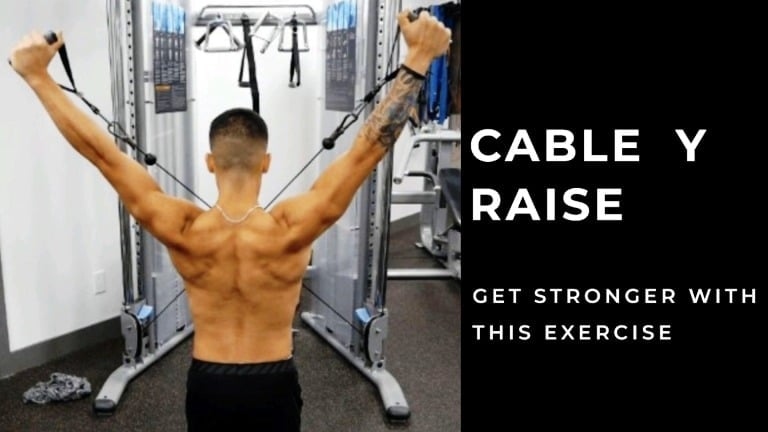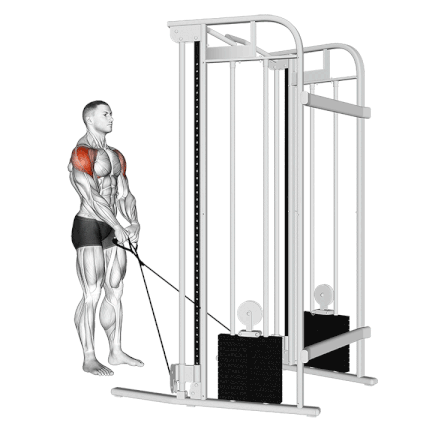The cable Y-raise is a fantastic exercise that targets the upper back and activates all deltoid fibers, including the front, lateral, and rear delts and traps. Because it is performed using a cable machine, it provides constant tension compared to a free-weight Y-raise.
This exercise combines horizontal shoulder abduction with external shoulder rotation, which helps to strengthen rotator cuff muscles.
It is an excellent exercise for strengthening the shoulders and offers many other benefits.
- It is a good alternative for people who feel uncomfortable doing a shoulder press.
- As it is more evenly distributed, it provides a constant load on your shoulder muscles throughout the entire range of motion.
- It offers almost unmatched versatility because you can easily change the load, angle, grip positioning, and body positioning.
- It’s a great option for those going through shoulder rehabilitation.

Muscles Worked During Cable Y Raise

The deltoid muscle of the shoulder consists of three separate sections or heads.
- The anterior deltoid (In front)
- Lateral deltoid (at the side)
- Posterior deltoid (behind)
All the three shoulder heads worked during the Cable Y raise, but
- The primary muscle that worked during Y Raise is the lateral deltoid.
- Secondary Muscle Worked during are: Anterior deltoid, posterior deltoid, trapezius, supraspinatus.
How To Do Cross-Body Cable Y Raise
- Attach D-handles to the low pulley setting on a cable machine.
- Grasp the left stirrup with your right hand and the right stirrup with your left hand.
- Step back slightly away from the pulleys and stand upright with the cables crossed in front of your hips.
- With elbows slightly bent, raise your arms upward and outward to the sides in a Y configuration until your elbows are approximately lateral to each ear.
- Hold for a second, and then slowly lower your arms back to the starting position.
- Do 8-12 reps and 3-4 sets.

Pro-Tips and Form
- Maintain a fixed, slightly bent elbow position throughout the exercise.
- Keep your torso still, your back straight, and your elbow slightly bent.
- Don’t just swing your arms. Keep controlled motion.
- Keep your shoulder blades back and down throughout the movement.
- Contract your shoulders at the top of the lift.
- As you get stronger, gradually increase the weight.
- It’s generally recommended to work your shoulders 1-2 times per week, with at least one day of rest in between workouts.
Variations of Cable Y Raise
These variations of the Cable Y Raise offer options for individuals with specific needs or those seeking variety in their workouts.
1. Seated Cable Y Raises
This exercise is good for people who have problems with their lower body or who like to exercise sitting down.
2. Single Arm Cable Y Raise
In this unilateral version, only one side of the deltoids is trained at a time. It allows for better focus and mind-body connection, potentially leading to more effective training stimuli.
3. Resistance Band Cable Y Raise
If you don’t have a cable machine or want to change up your routine, a resistance band is a good alternative. It has similar advantages to a cable machine, such as constant tension and variable resistance levels.
Cable Y Raise Alternatives
Before we deep dive into the best Cable Y Raise alternatives. We must remember a cable Y Raise alternative will be able to satisfy the following criteria:
- Activate the deltoid muscle groups, which are trained in the Cable Y Raise
- Isolate the muscle groups during execution
- Train the deltoid muscle through a longer range of motion
1. Dumbbell Lateral Raise
Lateral raises are a simple yet effective exercise that can help you target the shoulders, particularly the lateral or middle deltoid muscles. This exercise is great for strengthening the shoulder and should be included in your workout routine.
2. Face Pull
Face pull primarily targets the deltoid and, to a lesser degree, targets the biceps, triceps, and traps. Use a cable pulley machine to pull the weight straight toward your forehead.
This exercise prevents muscular imbalance and builds overall shoulder strength.
3. Arnold Shoulder Press
The Arnold dumbbell shoulder press is a great exercise for building shoulder muscles. Arnold’s press stands out from the crowd as the best exercise with the best range of motion.
It gives a wide range of motion as you lower the dumbbells well down in front, giving that maximum stretch other shoulder exercises lack.
Related Posts
- Franke Rde A, Botton CE, Rodrigues R, Pinto RS, Lima CS. Analysis of anterior, middle and posterior deltoid activation during single and multijoint exercises. J Sports Med Phys Fitness. 2015 Jul-Aug;55(7-8):714-21. Epub 2014 Jun 20. PMID: 24947920.

Manish is a NASM-certified fitness and nutrition coach with over 10 years of experience in weight lifting and fat loss fitness coaching. He specializes in gym-based training and has a lot of knowledge about exercise, lifting technique, biomechanics, and more.
Through “Fit Life Regime,” he generously shares the insights he’s gained over a decade in the field. His goal is to equip others with the knowledge to start their own fitness journey.
